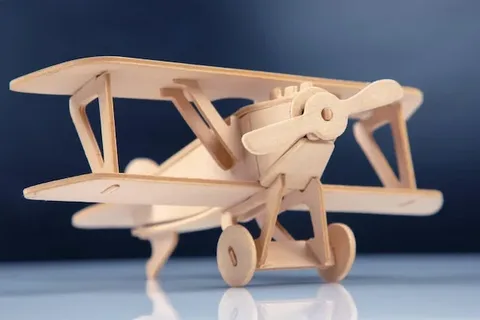The world of wooden aircraft models is a captivating hobby that combines craftsmanship, history, and aviation. These beautifully handcrafted models not only capture the elegance and complexity of real aircraft but also offer a unique, hands-on experience for aviation enthusiasts and collectors. Whether you are a beginner or an experienced modeler, wooden aircraft models provide an exciting challenge and an opportunity to appreciate the art of aviation on a smaller scale. In this blog, we’ll delve into the charm of wooden aircraft models, why they stand out, and how you can start creating or collecting them.
What Are Wooden Aircraft Models?
Wooden aircraft models are meticulously crafted replicas of real-life planes, built primarily from wood. Unlike plastic or die-cast models, the beauty of wooden models lies in their natural material, which allows for intricate detailing and a timeless aesthetic. These models range from simple, beginner-level designs to advanced, high-detail representations of historic and modern aircraft.
Each model is carefully shaped, painted, and assembled to resemble the real aircraft, and in many cases, skilled artisans make these models by hand. Whether it’s a vintage World War II fighter or a modern-day commercial airliner, wooden aircraft models offer a tangible connection to the history of aviation.
Why Choose Wooden Aircraft Models?
There are several reasons why collectors and aviation enthusiasts prefer wooden aircraft models over their plastic counterparts. Let’s explore some of the key benefits:
1. Durability and Longevity
Wooden models are incredibly durable when properly cared for. Unlike plastic models, which can become brittle and crack over time, wooden models retain their integrity for decades. Their sturdy construction ensures that they remain intact even with handling or environmental changes.
2. Aesthetic Appeal
There’s something inherently beautiful about the grain of the wood and the smooth finish that comes with wooden models. The natural look of wood adds character, and with the right detailing and painting, these models take on a life of their own. Wooden models often feel more authentic and artistic than plastic, giving them a timeless charm that adds to their value.
3. Customization Options
One of the greatest advantages of working with wood is the ability to personalize your aircraft model. Whether you want to create a specific historical livery, weather the plane to reflect years of service, or build a custom model from scratch, the possibilities for customization are endless.
4. Educational Value
Building or collecting wooden aircraft models provides insight into the mechanics and history of aviation. Each model serves as a miniature piece of history, allowing enthusiasts to learn more about different aircraft, their designs, and the role they played in global conflicts or commercial aviation.
Types of Wooden Aircraft Models
Wooden aircraft models come in various levels of complexity, making them suitable for modelers of all experience levels. Here’s a breakdown of the most common types:
1. Beginner-Level Models
If you’re new to the world of modeling, start with beginner kits that are simple and easy to assemble. These models generally consist of fewer parts, are pre-cut, and may require minimal tools. They are an excellent choice for beginners who want to develop their skills before moving on to more complex designs.
2. Intermediate Models
For those who have a bit of experience in modeling, intermediate kits offer more intricate designs and require a higher level of skill. These models often feature more parts, require additional cutting and sanding, and may involve more detailed painting. The assembly process is more challenging, but it’s a great way to advance your skills.
3. Advanced Models
Advanced wooden aircraft models are designed for experienced modelers. These models may involve hundreds of small pieces that must be carefully shaped, painted, and assembled. They often replicate historically significant aircraft or highly detailed modern aircraft and require precision and patience.
4. Flight-Ready Models
For those looking to add an extra layer of fun, flight-ready wooden models are available. These models are designed not only for display but also for flight. Often powered by rubber bands or small electric motors, they bring an element of interactive play to the hobby. Flight-ready models offer a more challenging and rewarding experience for experienced hobbyists.
How to Build Your Own Wooden Aircraft Model
Building your own wooden aircraft model is a rewarding process. Whether you’re assembling a kit or crafting a model from scratch, here’s a step-by-step guide to help you get started:
Step 1: Choose the Right Model Kit
Select a model that matches your skill level. For beginners, look for simple designs that don’t require complex construction. For more advanced modelers, opt for a kit with more intricate details and challenging assembly steps.
Step 2: Gather the Necessary Tools
To build wooden aircraft models, you will need a variety of tools, including:
- A sharp hobby knife or small saw for cutting pieces
- Sandpaper to smooth rough edges
- Wood glue for assembly
- Paint and brushes for detailing
- Tweezers for placing small components
Make sure you have everything on hand before you begin.
Step 3: Assemble the Model
Start by carefully following the instructions provided with your model kit. If you’re using a pre-cut kit, you can begin assembling the parts. Be patient and make sure each piece fits correctly before applying glue.
Step 4: Sand and Smooth the Model
After the model is assembled, use sandpaper to smooth any rough edges and ensure the surfaces are even. This is especially important if you plan to paint the model.
Step 5: Painting and Detailing
Now comes the fun part—painting and detailing. Choose your paint colors carefully to match the design of the real aircraft. You can add decals, weathering effects, and other detailing to bring your model to life.
Step 6: Apply a Protective Finish
To protect your model, apply a clear coat to seal the paint. This will help preserve the paint job and protect it from dust and wear.
Benefits of Collecting Wooden Aircraft Models
Wooden aircraft models are not just for builders—they are a highly sought-after collectible. Here are some benefits of collecting these models:
1. Artistic Value
Wooden models are often considered works of art. The craftsmanship, attention to detail, and authenticity of each piece make them an appealing addition to any collection or display.
2. Educational Experience
Collecting wooden aircraft models is a fantastic way to learn about aviation history. Each model is a snapshot of a particular era or design, offering valuable insight into the evolution of aircraft.
3. Investment Potential
Limited edition wooden aircraft models can appreciate in value over time. As you build your collection, you may discover that some models become rare or even valuable in the future.
4. Sense of Accomplishment
For those who enjoy building their own models, the sense of accomplishment that comes from completing a wooden aircraft model is unmatched. It’s not just about having a model to display—it’s about the journey and the pride in creating something beautiful.
Conclusion
The world of wooden aircraft models offers a perfect blend of history, artistry, and craftsmanship. Whether you are building a model from scratch or collecting rare pieces, the hobby provides endless opportunities for creativity and learning. With their durability, aesthetic appeal, and educational value, wooden aircraft models continue to captivate aviation enthusiasts and collectors around the world. So why not embark on your journey today and add a timeless wooden aircraft model to your collection?





